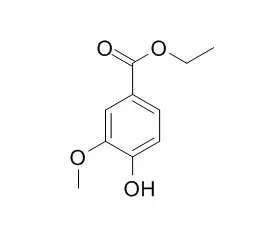| In vivo: |
| Calif Med. 1954 May;80(5):349-56. | | Disseminated coccidioidomycosis; treatment with ethyl vanillate; a preliminary report.[Pubmed: 13150209] |
METHODS AND RESULTS:
Ethyl vanillate, previously reported to be useful in the treatment of disseminated histoplasmosis, was administered to eight patients with disseminated coccidioidomycosis.
Therapeutically effective concentrations of Ethyl vanillate were obtained in only three patients, but, in them, the disease was apparently arrested. Failures occurred with patients who were too ill to tolerate the large amounts of Ethyl vanillate required to attain a therapeutic concentration in the blood. The principal difficulties of administering Ethyl vanillate are (a) the large doses required and (b) the lack of a parenterally administrable form of the drug.
CONCLUSIONS:
Ethyl vanillate, although not universally applicable, may be useful in selected cases of disseminated coccidioidomycosis and should be given further trial. | | Iran J Med Sci. 2015 Nov; 40(6): 478–484. | | Evaluation of the Efficacy of Topical Ethyl Vanillate in Enhancing the Effect of Narrow Band Ultraviolet B against Vitiligo: A Double Blind Randomized, Placebo-Controlled Clinical Trial.[Pubmed: 26538775] |
Vitiligo is an acquired disease of skin that presents with depigmented patches due to lack of melanocytes in the epidermis. Accumulation of toxic free radicals like hydrogen peroxide in the epidermis may be responsible for melanocytes death. Since Ethyl vanillate (vanillic acid ethyl ester) is a strong hydrogen peroxide scavenger, it may be effective against vitiligo. This study was carried out to evaluate the effect of Ethyl vanillate cream on vitiligo patients receiving phototherapy.
METHODS AND RESULTS:
A double-blind placebo-controlled clinical trial using Ethyl vanillate cream 20% was performed on 30 cases of generalized stable vitiligo (randomly selected) who were receiving phototherapy in the outpatient clinic of Faghihi Hospital (Shiraz, Iran). The patients randomly applied Ethyl vanillate on an assigned lesion (left or right side of the body) and placebo on the opposite side lesion (almost the same size and location) twice a day for 3 months, while receiving a narrow band ultraviolet B (NB-UVB) 2-3 times weekly. Photos were taken at the beginning of the trial and at the end of 4(th), 8(th), and 12(th) weeks. Then, images were compared with the photos from the beginning of the trial based on VASI score.
There was a significant change in pigmentation after applying Ethyl vanillate compared with baseline in medication side (P=0.002), but no significant change in placebo side (P=0.066). Additionally, there was a significant difference between medication and placebo sides in pigmentation (P=0.005).
CONCLUSIONS:
Ethyl vanillate may serve as an adjunct therapy for the treatment of vitiligo, although changes in pigmentation are mild clinically. |
|






 Cell. 2018 Jan 11;172(1-2):249-261.e12. doi: 10.1016/j.cell.2017.12.019.IF=36.216(2019)
Cell. 2018 Jan 11;172(1-2):249-261.e12. doi: 10.1016/j.cell.2017.12.019.IF=36.216(2019) Cell Metab. 2020 Mar 3;31(3):534-548.e5. doi: 10.1016/j.cmet.2020.01.002.IF=22.415(2019)
Cell Metab. 2020 Mar 3;31(3):534-548.e5. doi: 10.1016/j.cmet.2020.01.002.IF=22.415(2019) Mol Cell. 2017 Nov 16;68(4):673-685.e6. doi: 10.1016/j.molcel.2017.10.022.IF=14.548(2019)
Mol Cell. 2017 Nov 16;68(4):673-685.e6. doi: 10.1016/j.molcel.2017.10.022.IF=14.548(2019)